
Highly experienced wedding photographers in Bangalore, India covering pre-wedding, Engagement, Weddings, and Receptions across India!
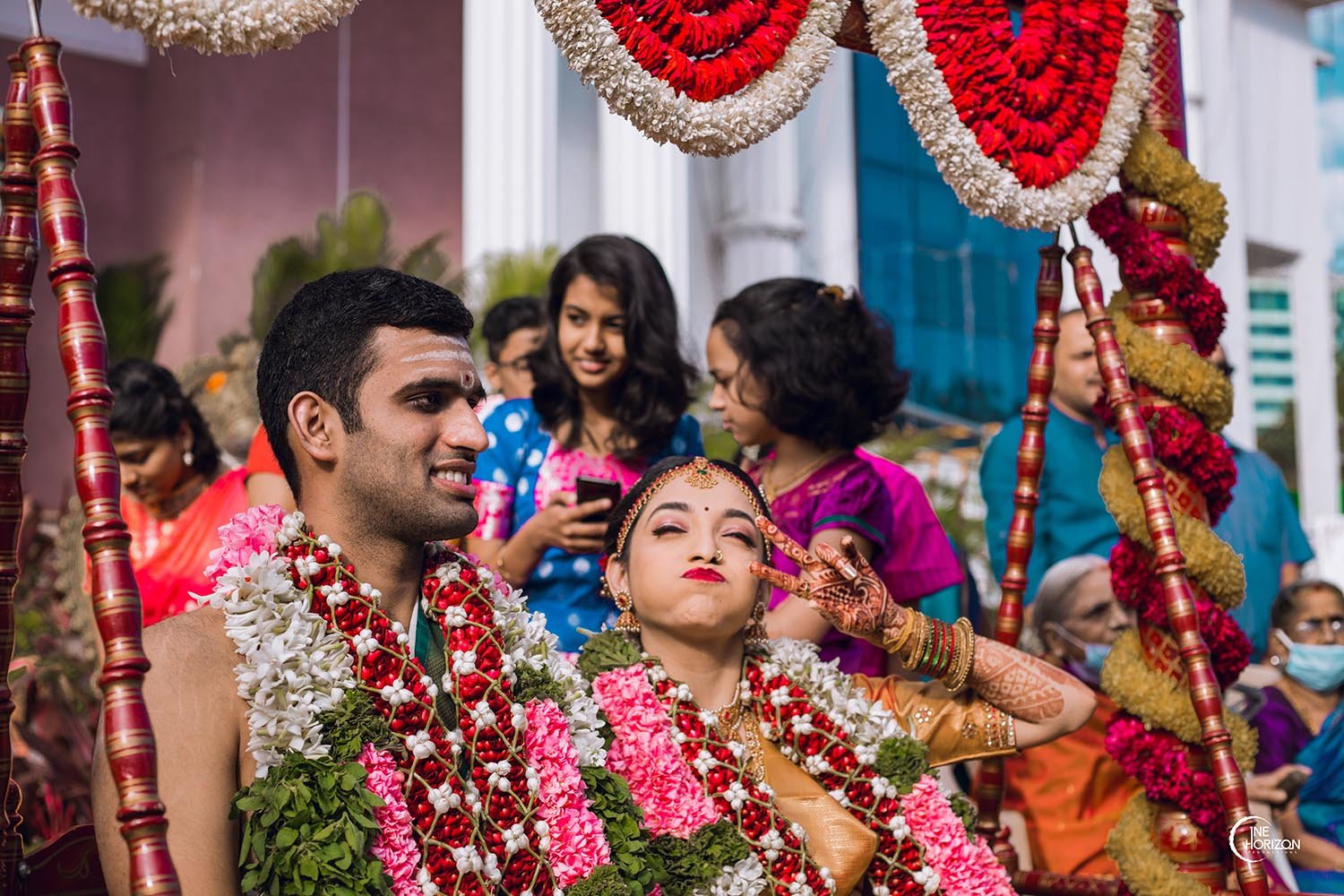
Rituals are the backbone of any society. They give us a sense of order and help to bind us together. Tamil Brahmin wedding rituals are the set of unique customs and practices that are performed in a Tamil Brahmin wedding. There is a deep meaning behind all these ancient wedding practices, find what they are in the section below.
Among the Tamil Brahmins, there are different sub-groups. Some of the rituals performed in a Iyer Tamil Brahmin wedding might not be the same as in Iyengar or Gurukkal TamBrahm wedding. The most common Tamil Brahmin wedding rituals are listed here.
Plan the perfect Tamil Brahmin wedding with our comprehensive guide. Learn about traditional Tambrahm wedding rituals, discover Tamil Brahmin wedding photos and videography options, and find everything else you need to make your special day unforgettable. Find all your Tamil Brahmin wedding planning needs in one place, now!
We, at One Horizon Productions, are one of the Premium Wedding Photographers in Bangalore, having covered 1500+ weddings. Penning down our experience of visiting all kinds of rituals, we are building this resource to guide you to your dream wedding.
This pre-wedding ritual is performed a few days before the wedding. The bride’s family offers prayers to the deity who is represented by a bamboo pole.
The story behind this ritual is that the Pandhal resting on bamboo poles had to withstand heavy winds and rain. So, to ensure a smooth wedding, the bride’s family worshipped the first pole.
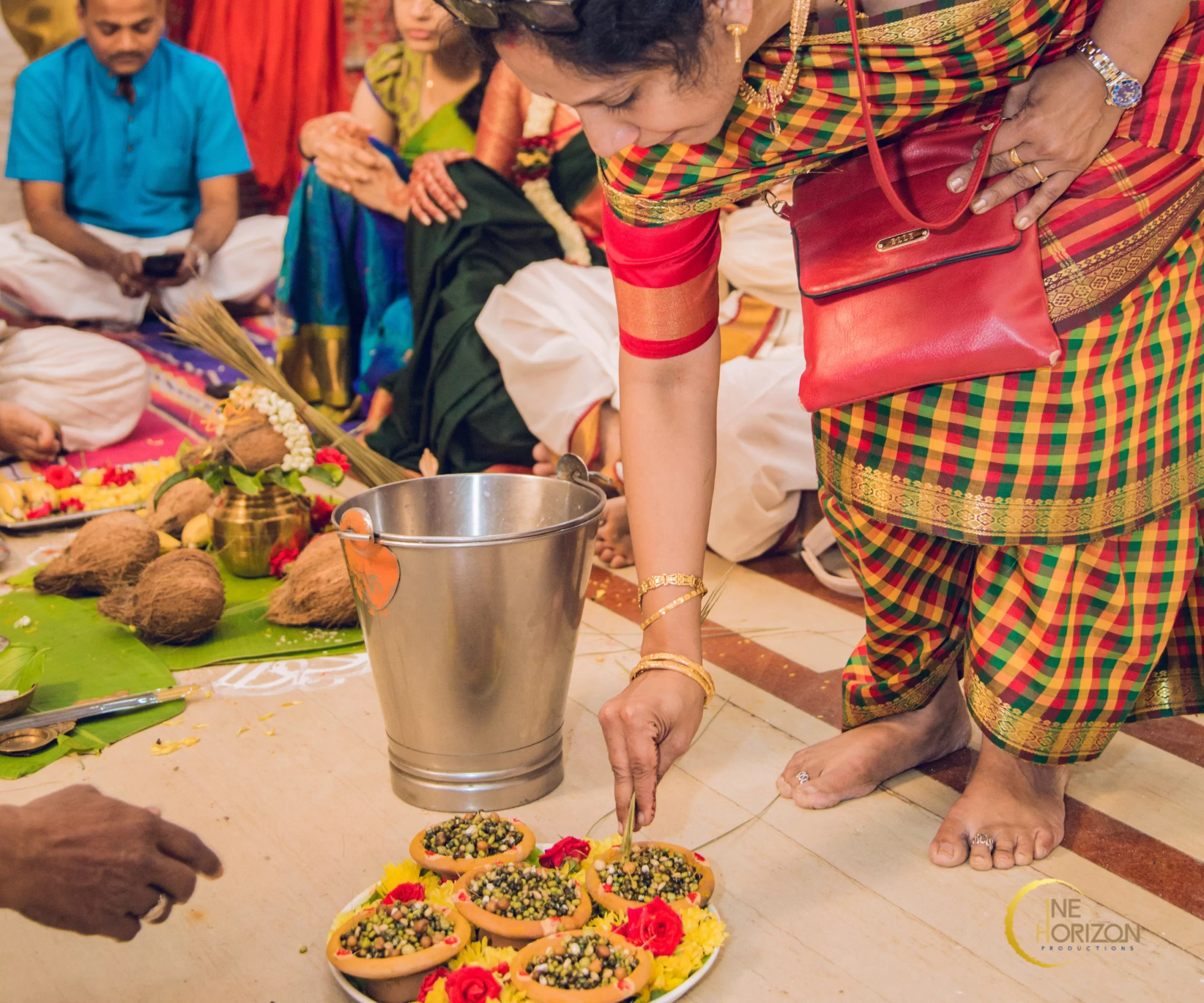
One day before the wedding, the bride’s family performs this ancient fertility rite to seek blessings of the nine devatas for the couple’s health and offsprings. Earthen pots spread with Vilvam leaves and Hariali grass are used.
Sumangalis (married women) sow nine types of pre-soaked cereals (for each devata) in these pots. Post marriage, the sprouted seedlings are spread in a pool or river.
A day before the wedding, the bride’s family gives a traditional and warm welcome to the groom and his family. A thali (tray) containing flowers, pakku, vetrilai, and fruits is prepared.
The groom is received with a sprinkle of panneer (rose water), Chandanam thilakam, kungunam, and flower garland. Bride’s mother welcomes the groom with a milk-based sweet dish called Thirattipal and sings Aarthi.
The Vratham ceremony marks the groom entering the next stage or ashram of his life, from Brahmacharya (bachelorhood) to Grihasta (householder).
The ceremony is separately performed by both the bride and the groom. Mantras are chanted to seek protection of the gods – Indra, Agni, Chandra, and Soma. Kappu (holy thread) is tied on the bride’s wrist to protect her from all evil.
Brahmins are invited and honoured with sweets and gifts in this ceremony. Both the families seek the blessings of these Brahmins who are believed to represent the ancestors of the groom and the bride.
Jaana Vaasam is a function where the bridegroom arrives in a parade in a beautifully decorated car. He is accompanied by parents of the bride as he reaches the mandapam from a nearby temple.
The procession is filled with music from a band, fireworks, and dancing children. Through this ceremony, the bride’s family seeks public approval of the chosen groom.
Nichchiyadhartham is the official engagement ceremony in Tambrahm marriages. It begins with Ganesh Pooja by the bride’s parents. The bride is gifted a new sari by the groom’s family. She is adorned with a chandan and kungumam tilak.
Her sari gets filled with thengai (coconut), fruits, pakku, vetrilai, manjal, and kungumam. The ceremony concludes with an Aarti and tying a garland around the bride’s waist.
This ritual involves the priest reading the wedding invitation. He announces the names of three generations of the bride’s and groom’s lineage. Other details such as venue and muhurtham are also discussed. After this, an elaborate dinner awaits the guests.
Among the Tamil Brahmins, there are different sub-groups. Some of the rituals performed in a Iyer Tamil Brahmin wedding might not be the same as in Iyengar or Gurukkal TamBrahm wedding. The most common Tamil Brahmin wedding rituals are listed here.
Plan the perfect Tamil Brahmin wedding with our comprehensive guide. Learn about traditional Tambrahm wedding rituals, discover Tamil Brahmin wedding photos and videography options, and find everything else you need to make your special day unforgettable. Find all your Tamil Brahmin wedding planning needs in one place, now!
Mangala snaanam is an important ritual in South Indian weddings where the bride and groom take a purifying bath in the morning of their wedding day. The ritual is performed separately for both the bride and groom at their respective homes. Haldi-kumkum tilak and oil is applied on them by their loved ones before the bath.
Among the Tamil Brahmins, there are different sub-groups. Some of the rituals performed in a Iyer Tamil Brahmin wedding might not be the same as in Iyengar or Gurukkal TamBrahm wedding. The most common Tamil Brahmin wedding rituals are listed here.
As with any other auspicious event, a Tamil Brahmin marriage begins with an invocation of lord Ganpathi – the destroyer of obstacles.
Families of the bride and groom may invite a priest to perform a prayer to appease the nine astral planets to bless the married life of the couple.

In continuation of the Vratham ceremony, Kasi Yatra is another important wedding ritual. After completing the Brahmacharya ashram, the groom is faced with two options – either to pursue a married life of a Grihasta or to take Sanyas (asceticism).
Under this ritual, the groom begins his journey to Kashi as an ascetic with his humble belongings (slippers, bamboo, fan, umbrella, etc.). The groom is interrupted by the bride’s father, who convinces him of the merits of a married life and promises the companionship of his daughter.
Fathers of the bride and the bridegroom face each other, while the priest chants vedic hymns in this Tamil Brahmin wedding ritual. The marriage ceremony is solemnised this way.

This is a fun ceremony, where the groom and bride exchange their garlands thrice. Friends and relatives of the bride and groom join them, helping them, or making it a little tough to exchange garlands. Groom’s friends might lift him too.
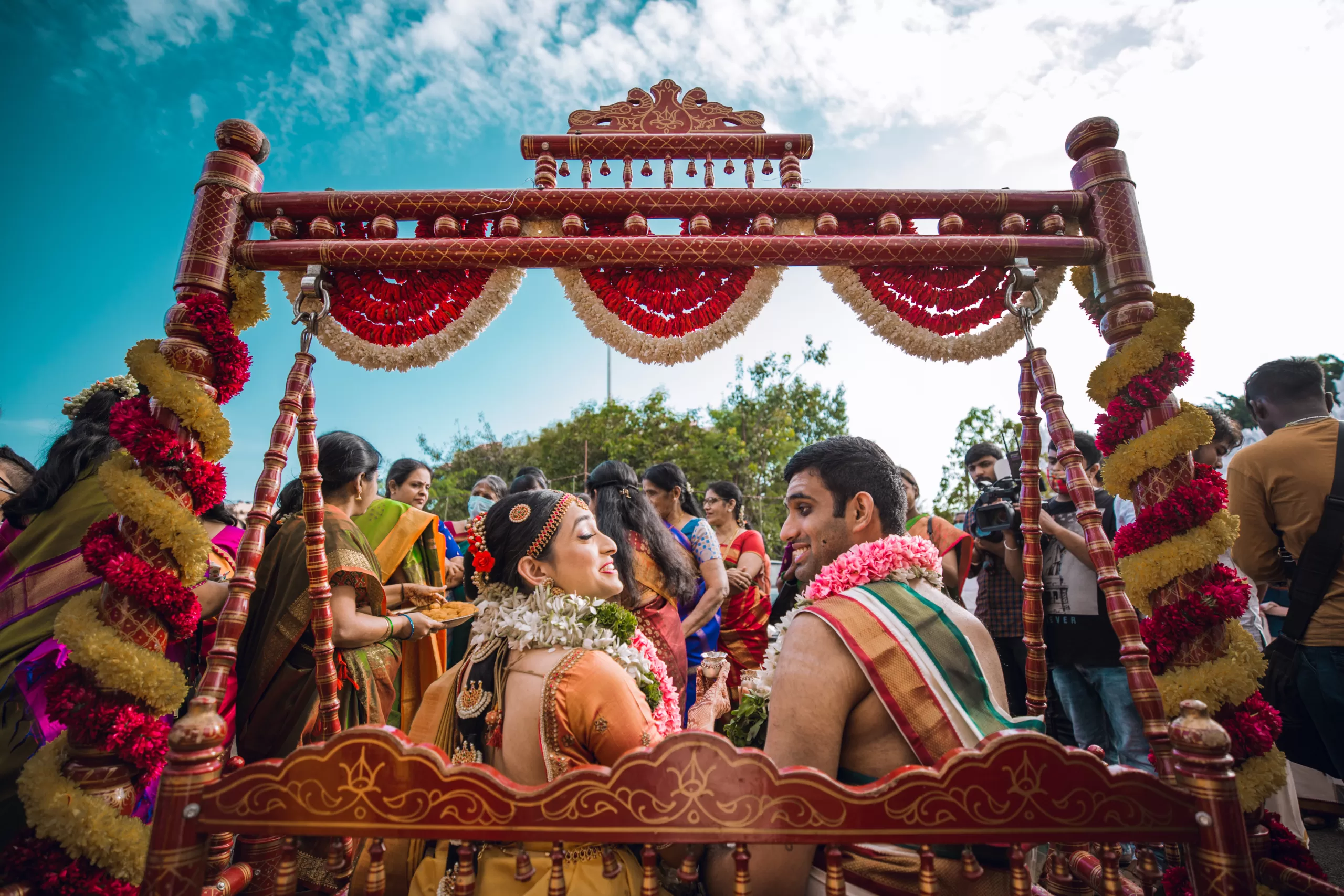
Oonjal is a swing on which the marrying couple sits and rides forth and back. They are surrounded by ladies who sing songs praising the couple (Laali).
The swinging chains are a representation of the unbreakable bond with the divine, and the swaying motion illustrates the ebb and flow of life. Despite these fluctuations, one can find inner peace and stability.
Vara Puja translates to groom worship. The ceremony involves giving a spoon of milk and banana to the couple after the Oonjal.
The wedding ceremony includes traditions to protect the couple from evil forces and bring good luck. One tradition is throwing rice balls in circular motions in four different directions.
Another tradition is women circling the couple holding either a lamp or a container of water. The bridegroom’s feet are washed in milk and dried with silk as part of the ceremony.
The groom is welcomed by the bride’s father at the mandapam. The bride’s father washes the groom’s feet, and the bride’s mother applies kajal to the groom’s eyes.
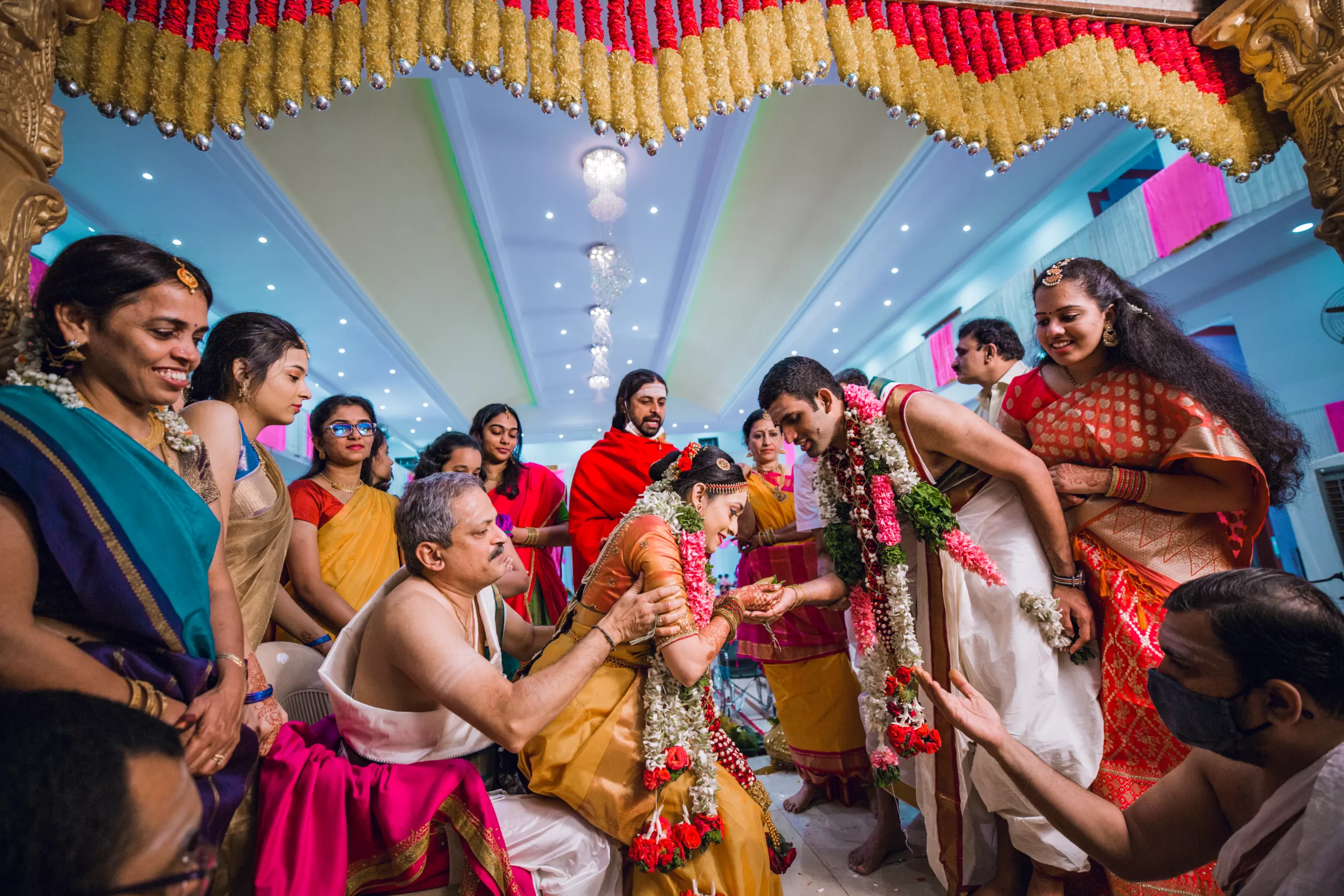
The bride sits on her father’s lap holding a coconut, and together they offer it to the groom while the bride’s mother pours water over it, symbolising the giving away of their daughter.
The groom’s parents gift the bride a nine-yard sari (Koorai), which she wears for the occasion of tying the mangalsutra. This is followed by the groom assuring the bride’s father of his companionship.

In a traditional Tamil Brahmin wedding ceremony, the bride ties a string around the groom’s wrist which is wrapped with a piece of turmeric.
This symbolises a religious vow binding them together. Only after the groom’s wrist is tied with the Kankanam can he touch the bride. Afterwards, the groom also gets to tie a Kankanam on the bride’s wrist.

In this ceremony, the groom ties Mangala Sutra to the bride. Several rituals such as placing the paddy sack on the floor which is symbolic of material and spiritual abundance and wealth.
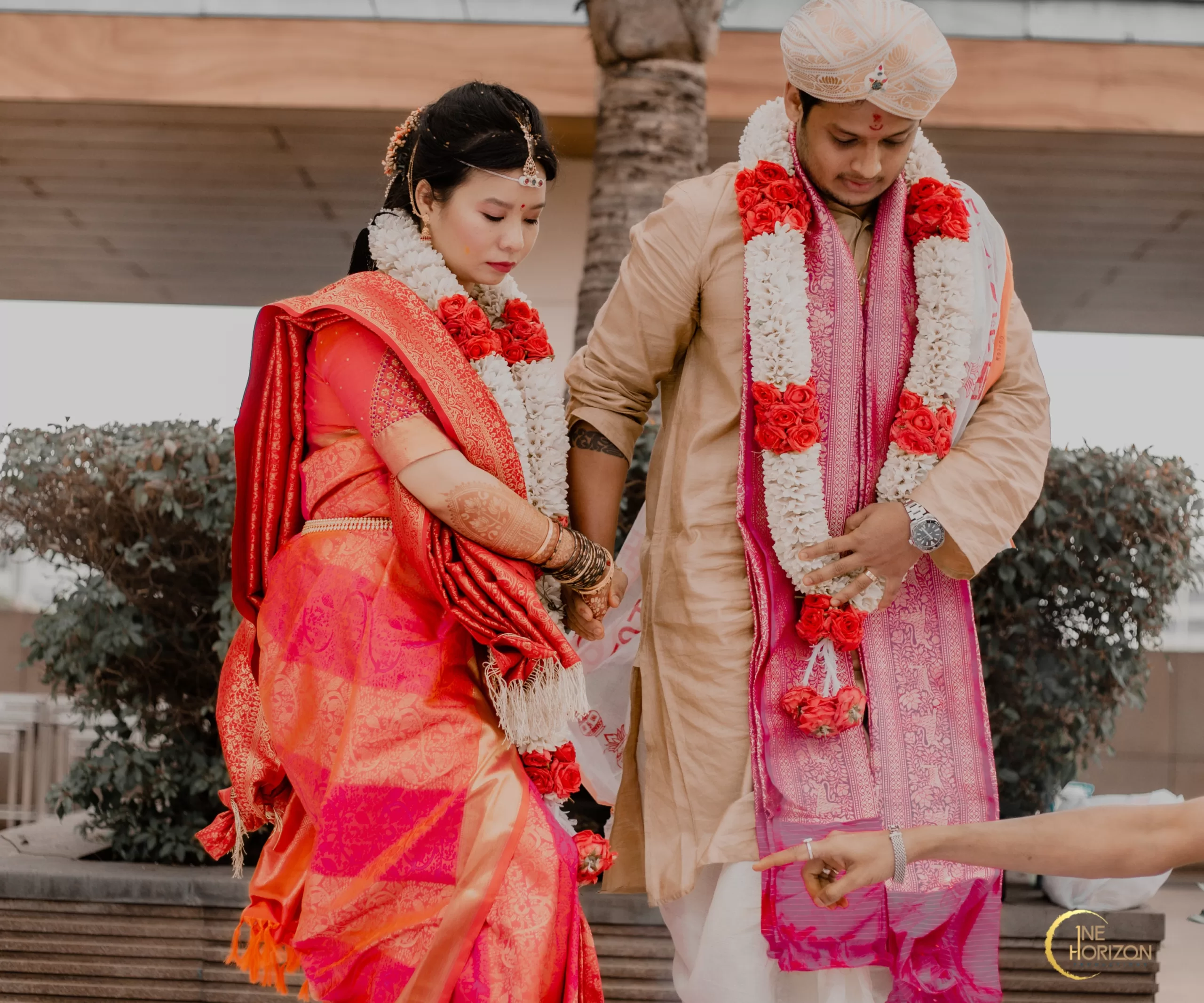
A marriage is said to be completed legally only after the ceremony of Saptha Padhi or seven steps. Holding hands, the bride and groom walk seven steps together. The seven steps represent their companionship and friendship for life.
Pradhaana Homam or hawan is a ceremony where the couple pays their respects to Aghni devta, the fire god. They ceremoniously walk around the fire, while feeding it ghee and other sacrificial fuel like twigs. Aghni is treated as a witness to the holy union of the couple (Aghni Saakshi)..
Ammi Midithal is a Tamil wedding ritual where the bride steps on a grindstone, with the help of the groom. Stepping on the stone a Mantra is chanted where it is prayed that the bride’s mind be as firm and strong as a rock to handle challenges of married life.
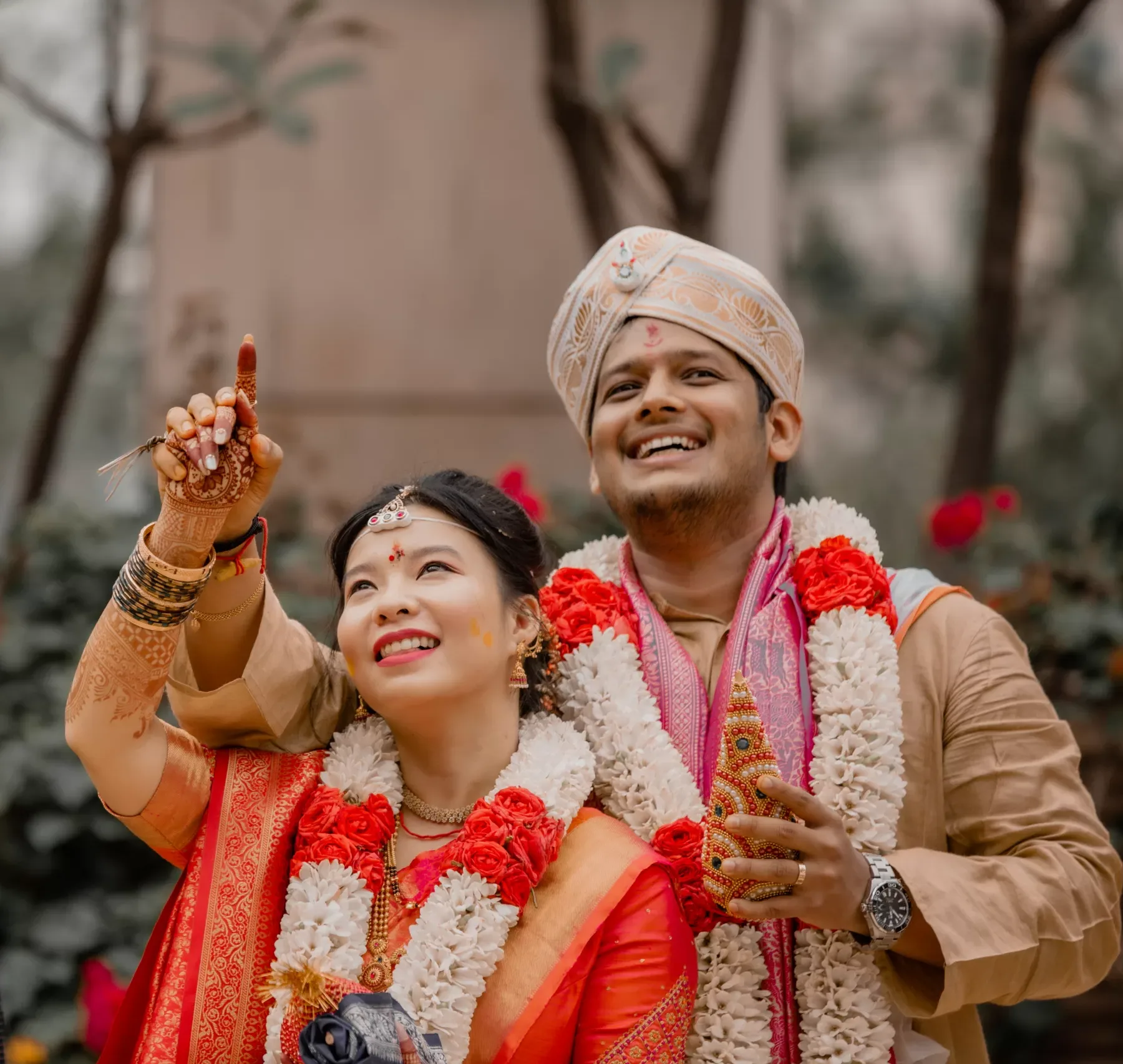
In this ritual, the groom points to the Arundhati star of the Saptha Rishi constellation and Dhruva tara (Pole star) to show to the bride.
Here the two families participate in exchange of gifts such as clothes and sweets.
The bride offers parched rice grains to the sacred fire. She then prays for the long and healthy life of his husband. The bride’s brother and other family members help her too. Their participation is an indication of the continued links between the members of their families, after the wedding ceremony.
Akshadai means the saffron and turmeric coated rice grains. These are showered on the newly weds by elders as blessings.
The new couple bows down to seek the blessings of the elders of the family. This ritual also involves offering fruits and a one rupee token to them.
Griha Pravesam is the ceremony where the bride leaves her maternal home to enter her husband’s home. She takes with her the holy fire of the Laaja Homam.
On the wedding afternoon, the newlyweds relax and play together with guests through playful activities like colour paste anointing, fanning, mirror showing, breaking papads, wrestling for a betel pack, and rolling a coconut. These activities showcase their positive qualities such as sporting spirit, strength, kindness and cooperativeness..
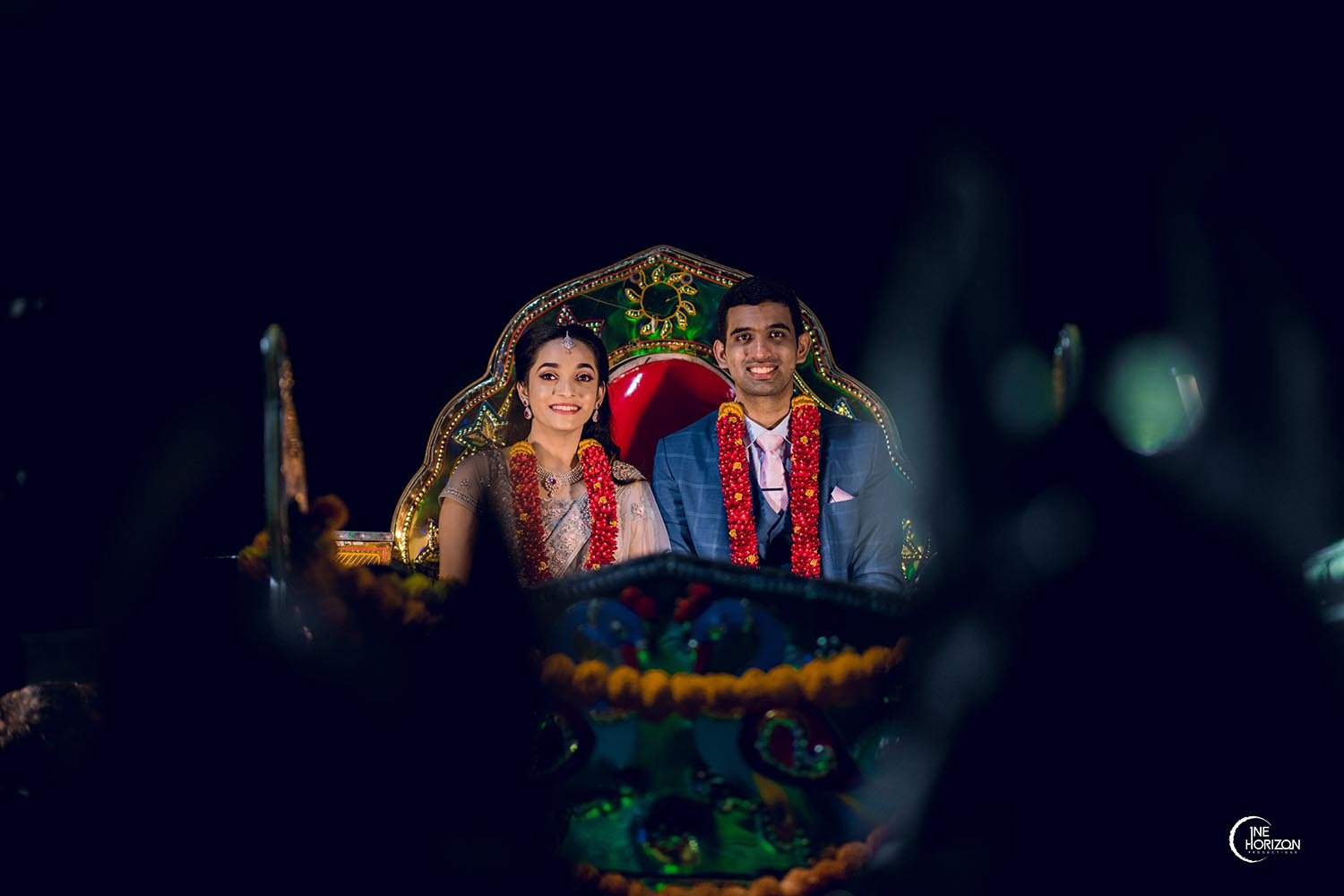
After the formal wedding ceremonies, the wedding reception is a casual and informal occasion where guests can meet the couple and congratulate their families.
The three havans or homams which are performed during the night time include Jayaathi Homam, Pravesa Homam, and Sesha Homam.
The Thaamboola Charvanam ritual is a ceremony in which the girl’s brother offers the couple their first betel leaf to chew. This is accompanied by other gifts that are meant to bless them with children and long life. The ritual is aimed at bringing good luck and prosperity to the couple.
To protect the bride and groom from evil eye, a special solution is prepared with turmeric powder and lime. It is circled around the couple and then thrown away. It’s done both during and after the wedding.
The day after the wedding ceremony, the bride’s family packs condiments like dal, rice, coffee powder, pickles, etc. for the groom’s family. They also offer them cooked food like coconut rice, tamarind rice, lemon rice, and curd rice for their journey back home.
Message on whatsapp or call our experts to plan your dream wedding now!
Are you looking for the best wedding photographers in Bangalore? Get a free quote.
Are you looking for the best wedding photographers in Bangalore? Get a free quote.
A traditional Tamil Brahmin bride typically wears a saree on her wedding day. The saree is usually red, which is considered to be an auspicious colour in Tamil culture. The bride may also wear a gold or silver pendant necklace and earrings.
Her hair is often styled in a traditional updo, and she may wear a gajra, or floral headpiece, in her hair. The bride typically finishes her look with red bindi, red bangles, and red vermilion powder in the centre of her forehead.
Paalikai Seeds Sowing, Pandhal Kaal Muhurtham, Vratham, and Nichchiyadhartham are some of the Tamil Brahmin pre-wedding rituals.
Looking for the best Tamil Brahmin Wedding photographers? With 20 years + experience, our in-house wedding photography and videography team will make your memories last a lifetime.
While the exact cost of a Tamil Brahmin wedding can vary depending on a number of factors, it is not uncommon for the total cost to be upwards of Rs. 12 lakhs. This cost can include the cost of the venue, catering, decorations, and other necessary expenses.
Some of the most popular items on the menu include idli, sambar, rasam, and curd rice. Of course, no Tamil Brahmin wedding would be complete without a huge spread of delicious sweets!
A Tamil Brahmin wedding is usually a two-day affair. But, the functions can go on till 5 days. The wedding festivities include pre-wedding ceremonies , wedding day rituals, and post-wedding functions. Guests are adorned with jewellery, flower garlands, and traditional South Indian attire (Sari for ladies and dhoti for the gents.
A Brahmin wedding is a sacred and ceremonial event in which two people are united in marriage. The bride and groom exchange marriage vows and exchange rings or other wedding bands.
They also exchange garlands or other symbols of their love and commitment. The wedding ceremony is usually officiated by a priest. After the ceremony, the newlyweds typically share a meal with their guests and celebrate their new life together.

Highly experienced wedding photographers in Bangalore, India covering pre-wedding, Engagement, Weddings, and Receptions across India!